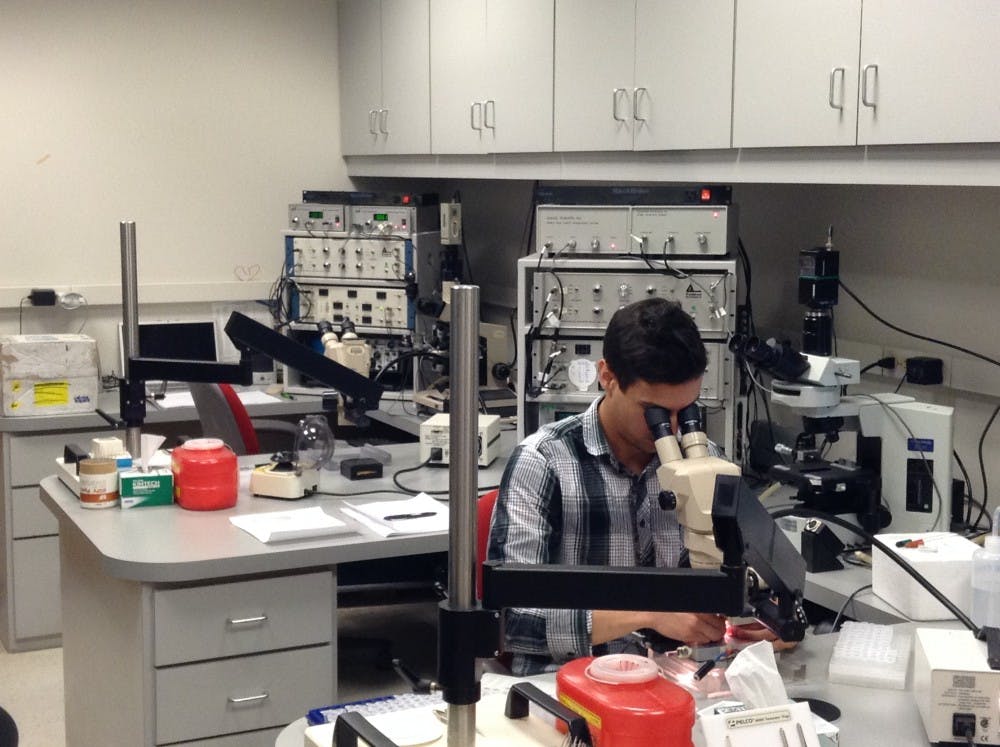
|
|
Kevin Murach, a doctoral student, separates muscle fibers from a NASA sample as part of the bed rest study the Human Performance Lab is conducting with NASA. He will stress test the fibers to see how strong they are. DN PHOTO ALAN HOVORKA |
Editor's note: This is the final article in a three-part series of space-related articles in celebration of the 45th anniversary of the moon landing. To see the first article, click here. To read the second article, click here.
|
Related articles: |
Scott Trappe has never been to space, but the half-dozen uniform patches on his desk have.
The director of the university’s Human Performance Lab collects them — his gifts from the astronauts who took them on missions to bring back as souvenirs.
“We were given a lot of these, and they were flown in space,” Trappe said. “One of the crewmembers said they make great coasters, and I had them accumulate here in my office and you know what? They do. They’re great conversation pieces.”
For two decades, Trappe and other Ball State faculty and students have been working with the space program, designing fitness programs and exercise equipment to keep astronauts healthy.
It’s more than just helping them avoid extra pounds in weightless orbit. Without exercise, a space traveler in zero-G conditions can age 50 years on a six-month trip. That’s because of the way bones and muscles deteriorate alarmingly when the body doesn’t have to work against gravity.
“For example, the crew up there now, if they were to go up there for six months and do nothing, they would come back and look like a frail 80-year-old,” he said.
Trappe and the others are proud of their space connections. In his office sits a framed photo of Hoosier astronaut Kevin Ford wearing a Ball State T-shirt while on the International Space Station. Ford’s sister is Nancy Richardson, an administrative coordinator in the Teachers College.
Forty-five years after Apollo 11 landed on the moon July 20, 1969, education centered on space and science is alive and well at Ball State.

|
|
A framed photo hangs in the hallway of the Human Performance Lab, showing a space shuttle crew along with a mission patch and Indiana flag that went to space. The hall is lined with several frames similar to this one. DN PHOTO ALAN HOVORKA |
Trappe’s lab is next to the Jo Ann Gora Student Recreation and Wellness Center. Access is tightly controlled because of the government contracts administered there, including studies on the effects of aging and how the absence of gravity causes an astronaut’s body to atrophy.
The first project looked at changes caused during a 17-day space shuttle flight.
“We’ve learned so much, how important exercise is in protecting crew health,” Trappe said.
The researchers don’t have to send people to space to find out how damaging inactivity can be.
Some of the Ball State studies for NASA use bed rest where subjects lie in bed for as long as 90 days at a time. They perform exercises and the researchers take muscle biopsies — small tissue samples — to see what exercise works best to prevent atrophy.
Similar samples have been taken from astronauts after they land.
That’s led to the current mission on the space station, which is a new program of high-intensity exercise.
“This program that’s being tested in space right now is the most sophisticated exercise program ever designed,” Trappe said.
At Ball State, students are heavily involved in the data collection and analysis.
One day in the lab recently, doctoral student Kevin Murach sat bent over a microscope with tweezers in his hands. His work involved muscle samples sent from NASA, where the bed rest studies are conducted, carefully separating each sample into individual muscle fibers.
He took a single fiber and pulled it taut with the tweezers, tying it with a microscopic piece of nylon to a machine for stress testing. The device tugs on the tissue, measuring its response to see how fast and powerful the person’s muscles have remained during the test.
The tests are repeated throughout the bed rest study to measure the changes in the subjects’ muscles.
“There are only a couple of labs like this in the world, so we are pretty lucky to get to do this with NASA,” Murach said.
Beyond lucky, actually. Murach called the work “mind-boggling.”
“Fifty years from now, we could be sending people to Mars,” he said. “And I know the exercise prescription I helped create allowed people to maintain muscle mass so they can do stuff when they get to Mars.”
However, without the first moon landing, Murach said, he wouldn’t be doing his research.
“If we couldn’t establish people landing a man on the moon, we wouldn’t be thinking about sending him to Mars or even in orbit,” he said.


![A member of Open Door Health Services [ODHS] Connections Team meets with a resident and assists them with enrolling in a health insurance plan in 2024. CEO and President of ODHS Bryan Ayars said around 10%-11% of their patients they see are uninsured. ODHS, Photo provided](https://snworksceo.imgix.net/bsd/6f04939c-59ef-4f5b-930d-1ab3f45749c1.sized-1000x1000.jpg?w=1000&ar=4%3A3&fit=crop&crop=faces&facepad=3&auto=format)


